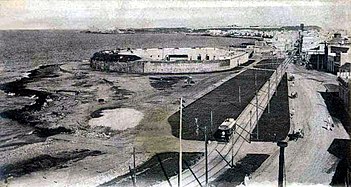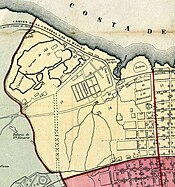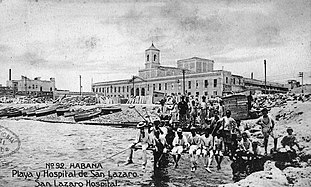Torreón de San Lázaro
| El Torreón de San Lázaro | |
|---|---|
 | |
 | |
| General information | |
| Town or city | Havana |
| Country | Cuba |
| Coordinates | 23°08′30″N 82°22′27″W / 23.141605482397°N 82.37408954425452°WCoordinates: 23°08′30″N 82°22′27″W / 23.141605482397°N 82.37408954425452°W |
| Opened | 1781 |
| Height | 9.14 metres |
| Dimensions | |
| Diameter | 4.57 metres |
| Technical details | |
| Structural system | Load bearing |
| Material | Masonry |
| Floor count | 1 |
The torreón is a cylinder, a round tower of masonry. El Torreón de San Lázaro, built on the shore of what was once the Caleta de San Lazaro or Juan Guillén, possibly at the end of the 17th century or the beginning of the 18th century as a day and night watchtower to warn the population and the guardians of the fortresses and walls of the presence of enemy ships.[1]The Torreón de San Lázaro is approximately 4.57 metres (15.0 ft) in diameter and 9.14 metres (30.0 ft) high with embrasures along its wall at the intermediate level and a battlement parapet at the third level roof.[1] It has a wooden entry door at ground level. With the passage of time, the San Lazaro cove was filled and the tower was included in a Republican-era park named after Major General Antonio Maceo. In an 1853 map of Havana it is shown as the Torreón de Vijias (lookouts). In 1982, the Torreón was inscribed along with other historic sites in Old Havana on the UNESCO World Heritage List, because of the city's importance in the European conquest of the New World and its unique architecture.[2]
History[]


The Torreón de San Lázaro is named for the nearby leprosarium at the Hospital de San Lázaro which was near the cove formerly known as the Cove of Juan Guillén. The Torreón de San Lázaro was conceived by the engineer Marcos Lucio, commissioned in New Spain for the construction and modernization of Havana's fortifications in the 17th century. In the minutes of the town hall, dated September 26, 1664, mention is made of a royal certificate that collects indications to make "a new fort in the cove that is half a league from the city." In the second half of the 19th century, it lost its defensive character before the location of the Battery of La Reina.[3]
From this fortification a lookout could warn military forces by way of torches of threats of attack by corsairs and pirates. In this regard, it served as a link in the defense chain between the Batería de la Reina, La Punta, and the Santa Clara Battery located at the site of today's Hotel Nacional.[4]
Gallery[]

Batería de la de la Reina

Map of Habana 1866

Hospital de San Lázaro, founded in 1781, showing Caleta de San Lazaro
See also[]
References[]
- ^ "Torreón de San Lázaro…! Qué vienen los ingleses!". Retrieved 2021-11-08.
- ^ "Old Havana and its Fortification System". UNESCO World Heritage Centre. United Nations Educational, Scientific, and Cultural Organization. Retrieved 26 May 2021.
- ^ "Torreón de San Lázaro, un vigía a los pies del mar". Retrieved 2021-11-09.
- ^ "Forts of Cuba". Retrieved 2021-11-08.
| Wikimedia Commons has media related to Torreón de San Lázaro. |
| Wikisource has the text of the 1911 Encyclopædia Britannica article "Havana". |
- Buildings and structures in Havana
- History of Havana
- Spanish colonization of the Americas
- 19th century in Havana
- Buildings and structures completed in 1781
- Coastal fortifications
- Spanish colonial fortifications in Cuba
- Fortifications of Havana
- Artillery batteries
- Architecture in Havana



